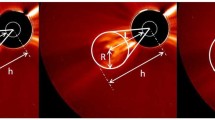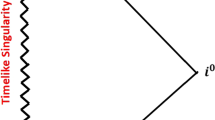Abstract
Motion of charged matter in gravitational and large-scale magnetic fields represents one of the most discussed topics in astrophysics. Here, one of the particular problems is addressed: the spiral motion of charged test particles as a possible mechanism for generation of weak toroidal magnetic field (magnetic loop) complementary to the prescribed large-scale one. To this aim, by contrast with the usually assumed scenario with particles circling in spirals along with the magnetic lines of a magnetic field dominating over gravity, the perturbed stable circular equatorial motion is discussed when the gravity of the central object plays at least a comparable role to electromagnetism. It is shown that the proper relation between the epicyclic and orbital frequencies necessary for the spiral motion cannot be easily achieved in the basic fields configuration within the Newtonian theory. The inclusion of the strong-field general relativistic effect, however, yields the desired conditions for particles to orbit in spirals.
Similar content being viewed by others
References
C. Cremaschini, Z. Stuchlík, Phys. Rev. E 87, 043113 (2013).
T. Jacobson, T.P. Sotiriou, Phys. Rev. D 79, 065029 (2009).
M. Kološ, Z. Stuchlík, Phys. Rev. D 82, 125012 (2010).
Z. Stuchlík, M. Kološ, Phys. Rev. D 85, 065022 (2012).
C. Cremaschini, M. Tessarotto, Phys. Plasmas 20, 012901 (2013).
J.E. Howard, M. Horányi, G.R. Stewart, Phys. Rev. Lett. 83, 3993 (1999).
J.E. Howard, M. Horányi, Geophys. Res. Lett. 28, 1907 (2001).
H.R. Dullin, M. Horányi, J.E. Howard, Physica D 171, 178 (2002).
B.W. Carroll, D.A. Ostlie, An Introduction to Modern Astrophysics (Addison-Wesley, New York, 1996).
M.A. Abramowicz, W. Kluzniak, Astrophys. Space Sci. 300, 127 (2005).
G. Török, Z. Stuchlík, Astron. Astrophys. 437, 775 (2005).
Z. Stuchlík, P. Slaný, G. Török, Astron. Astrophys. 463, 807 (2007).
V. Balek, J. Bičák, Z. Stuchlík, Bull. Astron. Inst. Czech. 40, 133 (1989).
Z. Stuchlík, J. Schee, Class. Quantum Grav. 27, 215017 (2010).
Z. Stuchlík, J. Schee, Class. Quantum Grav. 30, 075012 (2013).
A.N. Aliev, D.V. Galtsov, Gen. Relativ. Gravit. 13, 899 (1981).
P. Bakala, E. Srámková, Z. Stuchlík, G. Török, Class. Quantum Grav. 27, 045001 (2010).
O. Kopáček O, V. Karas, J. Kovář, Z. Stuchlík, Astrophys. J. 722, 1240 (2010).
R.M. Wald, Phys. Rev. D 10, 1680 (1974).
Author information
Authors and Affiliations
Corresponding author
Rights and permissions
About this article
Cite this article
Kovář, J. Spiral motion formation in astrophysics. Eur. Phys. J. Plus 128, 142 (2013). https://doi.org/10.1140/epjp/i2013-13142-9
Received:
Accepted:
Published:
DOI: https://doi.org/10.1140/epjp/i2013-13142-9




